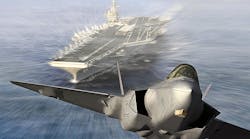Lockheed Martin (IW500/25) CEO Marillyn Hewson indicated the defense giant would meet the U.S. Department of Defense’s 6-7% target for cost-containment on the critical F-35 Joint Strike Fighter program. She confirmed in a conference call prior to Lockheed’s FY2016 earnings release that the cost would fall below the $100-million/jet price widely discussed, and targeted for criticism by President Donald J. Trump, and that the OEM continues to work with its hundreds of F-35 program suppliers to lower overall expenses to $85-million/jet by 2019.
Lockheed is the lead contractor for the F-35, a stealth-enabled, single-engine aircraft developed as a common platform for combat and air defense. The aircraft will be used by the U.S Air Force, U.S. Marine Corp., U.S. Navy, and the U.K. Royal Air Force, as well as defense ministries in several NATO and other Allied nations.
The basic jet design is offered in three variants: the F-35A for conventional takeoff and landing; the F-35B for short takeoff and vertical landing; and the F-35C for carrier-based operations.
Costs have been an ongoing concern for the F-35, nearly from the beginning of the program. Lockheed and other major contractors (BAE Systems, Northrup Grumman) committed to implement cost-cutting strategies and to meet new expense limits as early as 2014, and Lockheed has frequently restated its progress on these fronts.
The program has already built 200 aircraft, and Lockheed is awaiting federal funding for the tenth production lot. (Lockheed and F-135 engine builder Pratt & Whitney received funding to begin the procurement process for materials and systems in July 2016.) Lot 10 would total 94 jets of all variants, for the USAF, USMC, USN, and the Australian, Italian, Norwegian, Turkish, and U.K. air forces.
The cost issue became a new concern during December, when then President-elect Trump said the "tremendous cost and cost overruns" of the F-35 program led him to ask Lockheed rival Boeing to "price-out a comparable F-18 Super Hornet."
American Machinist is an IndustryWeek companion site within Penton's Manufacturing & Supply Chain Group.




